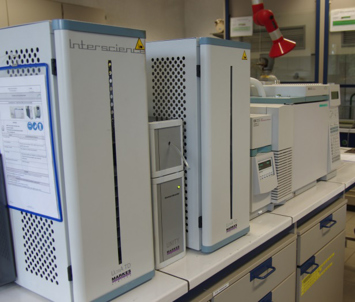
Tackling major challenges in air monitoring and emissions from materials
VITO, Belgium
 Poor air quality – and its consequent impacts on health – arise from a range of sources, including industry, vehicles, indoor construction materials, and consumer products. We talk to Marc Lor and Marianne Stranger at the research organisation VITO about how they’re using equipment from Markes International to study air quality in a wide range of scenarios across the globe.
Poor air quality – and its consequent impacts on health – arise from a range of sources, including industry, vehicles, indoor construction materials, and consumer products. We talk to Marc Lor and Marianne Stranger at the research organisation VITO about how they’re using equipment from Markes International to study air quality in a wide range of scenarios across the globe.
Who is VITO and what do you do?
We’re a major European research and technology organisation based in Belgium that offers advice, expertise and analytical services to organisations around the world on a range of topics centred on clean technology and sustainability – including energy, materials, health, environment and land use.
What types of organisations do you work with?
In the early years, we did a lot of work within national, European and international research projects, with a focus on generating data to inform policy development. However, in recent years we’ve shifted emphasis, and a lot of our time is now spent providing testing and consulting services for industrial clients, including product manufacturers, building and environmental consultants, and environmental specialists. However, we’re still involved in quite a bit of research, as well as regulatory activities, such as the development of harmonised test methods, and organising annual round-robin tests for workplace air assessment.
Is air quality a big aspect of your work?
It certainly is, and we’re heavily involved in all three major aspects – outdoor air, indoor air, and workplace monitoring. A key task for us is helping to contribute to the ‘knowledge base’ regarding the environmental impacts of products on indoor air quality. This knowledge is a fundamental first step in helping manufacturers to comply with new regulations and create safe, healthy and sustainable products.
What sort of equipment do you use for air and materials testing?
We have a wide range of equipment in our laboratories, allowing us to select the best technique for the analysis in question. Gas chromatography naturally is a mainstay of our work in VOC & SVOC analysis, and within that field, we use thermal desorption particularly to assess emissions from construction materials, furniture, automotive trim and consumer products. To do this, we use two TD100 automated thermal desorbers, and also a Micro-Chamber/Thermal Extractor for rapid emissions screening.
What are the key advantages of thermal desorption for you?
 Undoubtedly, the versatility of thermal desorption is of prime importance to us. From a productivity point of view, the fact that a single TD instrument can be used for analysis of compounds over a wide volatility range from a variety of sample types makes it an indispensable part of our laboratory. Thermal desorption also allows us to dispense with elaborate sample preparation steps needed for other methods, which streamlines our procedures.
Undoubtedly, the versatility of thermal desorption is of prime importance to us. From a productivity point of view, the fact that a single TD instrument can be used for analysis of compounds over a wide volatility range from a variety of sample types makes it an indispensable part of our laboratory. Thermal desorption also allows us to dispense with elaborate sample preparation steps needed for other methods, which streamlines our procedures.
And I guess your clients also have their own equally stringent requirements?
They certainly do! The usefulness of our results to our clients depends critically on achieving high reproducibility, which in turn demands low levels of experimental bias and minimal analyte carryover. Markes’ TD equipment of course performs very well on this front, and importantly gives us much lower detection limits than conventional solvent-extraction methods, allowing us to detect trace-level chemicals that would be missed by other techniques.
The importance of method-compliance
It’s absolutely essential, and underpins many of the decisions we make on choice of instrument and method for any given study. In particular, many applications in the field of air monitoring and material emissions are governed by standard methods, and so we greatly value Markes’ expertise in this area… and the fact that their TD equipment complies with standards from a number of agencies, including CEN, ASTM and ISO.
I’ve heard that you’ve been involved a European project on flame retardants. Can you tell me more about that?
Yes, certainly. The project is called ‘INFLAME’, and was funded under the EU’s 7th Framework Program. This project looked at the causes and impacts of indoor contamination with potentially neurotoxic and carcinogenic compounds such as polybrominated diphenyl ethers and organophosphates. Amongst a number of other stakeholders, our role was to identify an optimised method to test air streams for these semi-volatile chemicals, within the framework of established standard chamber-type testing methods.
What are the particular problems of monitoring semi-volatile compounds in air?
Although levels of SVOCs in air are often very low, the fact that many of them are hazardous to health means that limit levels are also low. This places great emphasis on lowering detection limits, which up to now has been achieved by taking very large sample volumes. However, sampling 1000 litres or more is very inconvenient, risks sample contamination or analyte loss, and is often completely impractical when air flow rates are restricted, such as when sampling from emission test chambers or personal monitoring.
How did you tackle this challenge?
Thermal desorption was a natural choice for us, to achieve high sensitivity while keeping sample volumes to a minimum. With this decision made, we first looked at speeding up the sampling method, and used Markes’ Micro-Chamber/Thermal Extractor to rapidly release VOCs and SVOCs from the sample material, in a way that is analogous to what happens in the multi-day reference tests using ‘small’ chambers. Using a multi-bed sorbent tube enabled us to reliably capture the range of flame retardants we were investigating, and these tubes were then analysed on Markes’ TD100 automated thermal desorber, with GC–MS analysis.
And were you pleased with the results?
Absolutely – we were able to achieve analyte recoveries >88%, detection limits as low as 6 pg/m3, linearities greater than 0.996, and repeatabilities below 10% for all studied compounds. This means we have a really robust, reliable method that can be used to generate meaningful data on comparison of emissions from different products, for example. This is crucial when it comes to assessing the potential impacts of these flame retardants on indoor air quality and human health.
How did Markes’ staff assist your research?
Through the whole process, Markes’ staff were fantastic in responding to our questions quickly and professionally – we’ve always valued their expertise in all aspects of thermal desorption, especially their skill in analytical problem-solving, and their knowledge of recent legislative & scientific developments.
What other projects are under way at the moment?
We’re currently working on a range of other studies relating to indoor air quality, all involving Markes’ TD equipment. These include REACH-related testing for chemicals released from consumer goods, a study into impacts from wood-based construction materials, and national studies of indoor air quality in Flanders and Qatar.
And what does the future hold for VITO?
It’s certainly going to be a busy time for us! A focus will undoubtedly be on continuing to support our clients with our knowledge and expertise in analytical chemistry, and looking for innovative ways in which analytical chemistry can help to tackle the challenges posed by the modern world – particularly in developing countries. Having cutting-edge instrumentation lies at the core of this, and so it should come as no surprise that we’re also looking to expand our TD capabilities with another TD100 instrument!
Full details of the flame retardants study can be found at:
- B. Lazarov et al., Air sampling of flame retardants based on the use of mixed-bed sorption tubes – A validation study, Environmental Science and Pollution Research, 2015, 22: 18221–18229.
For a broader study on using sorbent tubes and TD–GC–MS for the analysis of a range of semi-volatiles, including polycyclic aromatic hydrocarbons, polychlorinated biphenyls (PCBs), phthalate esters, and certain pesticides, see:
- B. Lazarov et al., Optimisation steps of an innovative air sampling method for semi volatile organic compounds, Atmospheric Environment, 2013, 79: 780–786.






